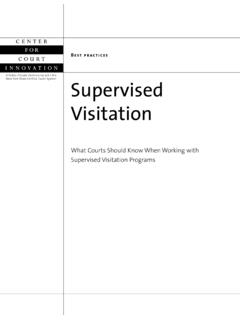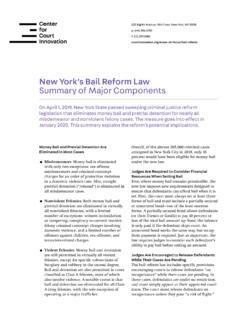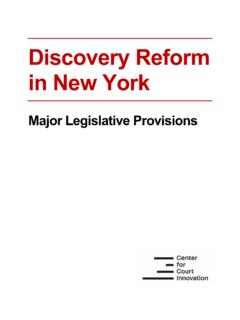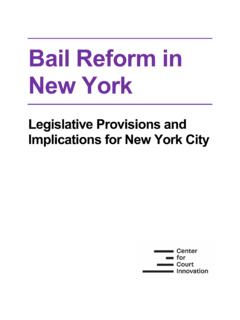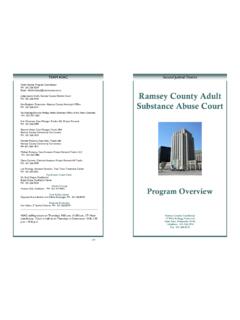Transcription of Principles of Problem-Solving Justice
1 Principles ofProblem-SolvingJusticebest practicesA Public /Private Partnership with theNew York State Unified Court SystemWritten byRobert V. Wolf2007 This publication was supported by Grant No. 2005-PP-CX-K0008awarded by the Bureau of Justice Assistance. The Bureau of JusticeAssistance is a component of the Office of Justice Programs, whichalso includes the Bureau of Justice Statistics, the National Institute ofJustice, the Office of Juvenile Justice and Delinquency Prevention,and the Office for Victims of Crime. Points of view and opinions inthis document are those of the author and do not necessarily repre-sent official positions or policies of the Department of the AuthorRobert V. Wolf is director of communications at the Center for CourtInnovation. AcknowledgementsAppreciation is extended to the following individuals who reviewedand commented on earlier versions of these Principles : Pam Casey,National Center for State Courts; Cait Clarke, consultant, formerdirector of the National Defender Leadership Institute; William , The National Judicial College; John Goldkamp, TempleUniversity; C.
2 West Huddleston III, National Association of DrugCourt Professionals; Steven Jansen, National District AttorneysAssociation; Wendy Lindley, Orange County (California) SuperiorCourt; Judy Harris Kluger, New York State Unified Court system ;Timothy Murray, Pretrial Justice Institute; and Carol Roberts, RamseyCounty (Minnesota) Community Corrections. The author would alsolike to thank Liberty Aldrich, Greg Berman, Carol Fisler, A. ElizabethGriffith, Julius Lang, Adam Mansky, Preeti P. Menon, Kim Norris,Valerie Raine, Al Siegel, Carolyn Turgeon, and Chris Watler for Justice can trace its theoretical roots to innovations in policing,particularly community and problem -oriented policing, which attempted to replacetraditional law enforcement s focus on responding to individual offenses with afocus on identifying and addressing patterns of crime, ameliorating the underlyingconditions that fuel crime, and engaging the community as an active the 1990s, these new policing strategies helped inspire similar approaches inthe rest of the criminal Justice system , helping give rise to innovations like commu-nity prosecution, community courts, and Problem-Solving probation.
3 These newexperiments shared an emphasis on data analysis, community engagement, crimeprevention, and problem solving . At their core was the idea that it was no longerenough just to arrest, process, and adjudicate an offender, but law enforcementofficers, prosecutors, judges, and probation officers also needed to try to reducerecidivism, improve public confidence in Justice , and prevent crime down the ideas influenced not only community courts but the other specializedcourts drug, domestic violence, reentry, mental health courts that emerged inthe United States in the 1990s. It was while describing these various court initia-tives that New York State s chief judge, Judith S. Kaye, catapulted the idea of prob-lem- solving Justice to a national audience. Kaye, in a column in Newsweek in 1999,extolled the virtues of these Problem-Solving courts for their ability to addressproblems like drug addiction, mental illness, and homelessness.
4 The Conference ofChief Judges and Conference of State Court Administrator soon passed resolutionsendorsing continued experimentation in this area. The American Bar Associationquickly followed there are over 2,500 Problem-Solving courts in the United States, and agrowing body of research literature has begun to validate their days, innovators have begun to tackle a new challenge: applying the princi-ples of Problem-Solving courts beyond specialized courts. A real-life example of thisapproach is Bronx Community Solutions, an initiative in the criminal courthouse inthe Bronx, New York, that offers alternative sanctions including social servicesand community restitution to judges in more than 40 courtrooms. The goal is toprovide judges who preside over conventional courtrooms with access to the samesanctions, links to social services, and rigorous monitoring that are more commonlyoffered in drug, mental health, or community of Problem-Solving Justice1 IntroductionIf there are to be more projects like Bronx Community Solutions that seek to goto scale with Problem-Solving Justice , there needs to be agreement on just whatdefines problem solving .
5 Various experts and organizations, including the Centerfor Court Innovation, have attempted to define Problem-Solving Justice in recentyears. This is no simple the biggest challenge has been identifying Principles that are broadenough to encompass all Problem-Solving initiatives without being so broad thatthe description becomes meaningless. The diversity of Problem-Solving models isreflected in the different assumptions about rehabilitation posited by drug anddomestic violence courts. While drug courts seek to return offenders to society asproductive citizens, domestic violence courts emphasize punishment and victimsafety. In other words, drug courts are focused on rehabilitation, and domestic vio-lence courts are focused on holding offenders accountable and keeping their differences, however, there are a number of Principles that domes-tic violence, drug, and other Problem-Solving courts share. This paper is an attemptto describe those six Principles outlined below are based on the Center for Court Innovation sexperience developing Problem-Solving initiatives in New York.
6 The Center has alsoserved as a consultant to dozens of jurisdictions throughout the United States andthe world, including as the technical assistance provider under the Bureau ofJustice Assistance s Community-Based Problem-Solving Criminal Justice developing these Principles , the Center analyzed Problem-Solving projectsfrom across the country and also consulted with experts from national organiza-tions, including The National Judicial College, the National Center for State Courts,and the National Association of Drug Court InformationBetter staff training (about complex issues like domestic violence and drug addiction)combined with better information (about litigants, victims, and the community con-text of crime) can help improve the decision making of judges, attorneys, and otherjustice officials. High-quality information gathered with the assistance of technolo-gy and shared in accordance with confidentiality laws can help practitioners makemore nuanced decisions about both treatment needs and the risks individual defen-dants pose to public safety, ensuring offenders receive an appropriate level of supervi-sion and traditional courtrooms, judges and court staff often don t have specializedknowledge of the problems affecting offenders or victims, such as drug addic-tion, mental illness, family dysfunction, and domestic violence.
7 Sometimesjudges and attorneys argue that they should deliberately avoid gaining special-ized knowledge, fearing it might affect their objectivity. But those who haveworked in Problem-Solving courts have found that background knowledgeCenter for Court Innovation2 Principlesabout an issue doesn t contribute to bias and only enhances their ability tomake informed decisions. In Brooklyn, New York, for example, judges many years ago routinely dis-missed charges if a victim of alleged domestic violence withdrew her com-plaint. But after the founding of the Brooklyn Domestic Violence Court in1996, all felony domestic violence cases were brought before a single judge,who d been trained in the dynamics of domestic violence and therefore knewthat victims often drop charges for reasons having nothing to do with theveracity of the complaint typically because they feel intimidated. With thatknowledge, Judge John Leventhal considered on a case-by-case basis whether to improve the victim s sense of safety by increasing pre-trial monitor-ing of a defendant or encourage prosecutors to seek corroborating evidence(apart from the victim s testimony).
8 To make more informed decisions, judges and other staff also need anotherkind of knowledge: specific information about the physical and psychologicalhealth of defendants and litigants. An essential ingredient of many Problem-Solving programs is a thorough intake interview during which a case manager(or other trained staff ) gathers information about individual defendants and lit-igants. A typical psycho-social assessment collects information on education,employment, health, mental illness, and other issues. Staff can use this infor-mation to develop individualized service plans for defendants and to help thejudge and other decision makers make better decisions. Defendants are not the only ones who can benefit from services, of , in domestic violence courts, the focus of social service intervention istypically not the defendant but the victim. Victim advocates in domestic vio-lence courts conduct intake interviews with victims who are seeking knowledge of each victim s needs, advocates can customize a safety planto provide appropriate support and resources.
9 Whether information comes from a victim or a defendant, problem -solvingcourts must ensure that personal information (which may be potentiallyincriminating or may undermine someone s safety) is protected. Many prob-lem- solving courts have established confidentiality protocols and agreementsin advance by engaging prosecution, court administrators, probation officials,and defense attorneys in the planning kind of information often lacking in conventional courts is knowl-edge about the community context of crime. Clearly it matters if a drug sale isa lone incident on an out-of-the-way street corner or one of many similarcrimes taking place near a school or an apartment building full of most judges rarely have access to such contextual information. In contrast,community court judges routinely meet with community groups and make apoint of touring neighborhood locations to get a better understanding of condi-tions and local concerns.
10 Many community courts also have advisory boardswhose membership is drawn from community residents and other stakehold- Principles of Problem-Solving Justice3ers. The Hartford (Connecticut) Community Court, for example, has an adviso-ry board whose members are drawn from 17 Problem-Solving committeesthroughout the city. Every month, the committee meets with representatives ofthe court including the judge to discuss community conditions (but notspecific cases).There are other tools that can be used to enhance information:Education Some states have sponsored training sessions for judges andother key courtroom players. Through such trainings states can, forexample, ensure that all drug court judges understand basic pharmacol-ogy or how to apply sanctions and rewards. Training can also be con-ducted on a more local and less formal basis. Individual projects, forinstance, can host brown bag lunches and lectures to keep staff up todate on best practices and topics of interest.


